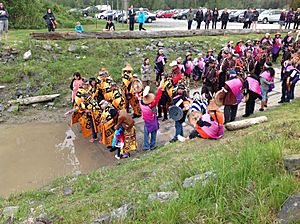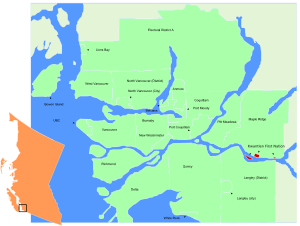Kwantlen First Nation facts for kids
Quick facts for kids
Kwantlen First Nation
qʼʷa:n̓ƛʼən̓
|
|
|---|---|
 |
|

Location of Kwantlen in Metro Vancouver
|
|
| Country | |
| Province | BC/BCE |
| Government | |
| • Type | Band council |
| Area | |
| • Land | 5.59 km2 (2.16 sq mi) |
| Population
(2022)
|
|
| • Total | 375 |
The Kwantlen First Nation (called qʼʷa:n̓ƛʼən̓ in their own language) is a First Nations group in British Columbia, Canada. Their main community is on McMillan Island near Fort Langley. The Kwantlen people traditionally speak hən̓q̓əmin̓əm̓. This is the Downriver dialect of Halkomelem, which is part of the Salishan language family.
The Kwantlen are a Stó:lō people. This larger group includes other First Nations like the Katzie and Kwikwetlem. In June 2018, the Kwantlen Nation decided to leave the Stó꞉lō Tribal Council. They now operate as an independent Nation.
Contents
Kwantlen History and Culture
The history and culture of the Kwantlen people are closely linked to the larger Stó:lō group. Before Europeans arrived, the Kwantlen were one of the largest First Nations in the Lower Fraser River area. They were also a leading group among the Stó:lō people.
Where Did Kwantlen People Live?
The Kwantlen lived in many important village sites across their territory. These areas include places known today as New Westminster, Surrey, Langley, Maple Ridge, and Mission. The main village was called sχəyəməɬ, located where New Westminster is now. Across the river in Surrey, they had a summer fishing village called qəqəyt. The Stave River valley was also very important. People used it for hunting, trapping, gathering cedar bark, and fishing.
How Did Europeans Change Kwantlen Life?
After Europeans arrived, the Kwantlen moved their main settlement. They moved from New Westminster upriver to Fort Langley. The Hudson's Bay Company had built a trading post there in 1829. The Kwantlen wanted to control trade with the Hudson's Bay Company.
The Kwantlen were very important to the British settlement at Fort Langley. This was clear when Hudson's Bay Company men joined Kwantlen warriors. They worked together to fight off an attack by the Euclataws from Quadra Island. This victory helped stop slave raids on the lower Fraser River by northern tribes. It was also the only time British and Indigenous forces fought together in British Columbia.
However, the Kwantlen lost power after British Columbia became a colony. Their power lessened even more when British Columbia joined Canada. The government then took control and assigned their affairs to an Indian Agent. This agent was appointed by the government in Ottawa.
What Does the Name Kwantlen Mean?
In early European records, the Kwantlen people were called by different names. These included Quoitlen and Quaitlines. In the late 1800s, the Kwantlen First Nation became known as the "Langley Indian Band." This name was official and used by the Canadian government until 1994.
In June 1994, former Chief Marilyn Gabriel brought back the traditional name of Kwantlen. This was celebrated with a special ceremony. Kwantlen Polytechnic University was allowed to use the Kwantlen name by the late Sto:lo Grand Chief Joe Gabriel. The name "Kwantlen" means "Tireless Runner" in the Halkomelem language.
Kwantlen First Nation Today
The Kwantlen First Nation is a modern and growing community. It is led by a hereditary chief and council. They also get advice from a formal Elders Advisory Committee. This committee meets once a month.
Cultural Revival and Growth
With this guidance, the community has seen a strong return of its culture. They have also experienced good economic growth. For example, they opened a new Cultural Centre. There is also a renewed focus on learning the Halkomelem language. The annual First Salmon Ceremony is another important cultural event.
The Kwantlen Nation operates under the First Nations Land Management Act. This means they have their own Kwantlen Land Code. This code allows them to manage their reserve lands themselves. They do not have to follow 34 sections of the Indian Act related to land management.
Kwantlen Businesses
The Kwantlen First Nation owns several businesses. These businesses help their community grow and thrive. Some of their business groups include:
- Seyem' Qwantlen Business Management Ltd.
- Seyem' Qwantlen Construction Ltd.
- Seyem' Qwantlen Development Ltd.
- Seyem' Qwantlen Resources Ltd.
- Seyem' Qwantlen Ventures Ltd.
- Lelem Hospitality Ltd.
- Seyem' Qwantlen Harbour Authority
- Kwantlen Lands, Resources and Stewardship Ltd.
- Seyem' Qwantlen Housing Society
Besides these businesses, Seyem' Qwantlen also works on heritage and stewardship projects. These projects aim to improve local fisheries, wildlife, and habitats. They also help teach non-Native communities about the Kwantlen people and their rich culture.
Kwantlen Territory and Reserves
The Kwantlen First Nation manages six Indian Reserves. These are special areas of land set aside for First Nations.
Kwantlen Indian Reserves
- Langley Indian Reserve No. 2: This reserve is on the west bank of the Stave River. It is about 1 mile from where the Stave River meets the Fraser River.
- Langley Indian Reserve No. 3: This reserve is on an island at the mouth of the Stave River.
- Langley Indian Reserve No. 4: This reserve is on the east bank of the mouth of the Stave River. It is next to Silvermere Lake.
- Langley Indian Reserve No. 5: This reserve is on the north bank of the Fraser River. It is about 2 miles northeast of Fort Langley, east of Albion.
- Whonnock Indian Reserve No. 1: This reserve is located between Whonnock (west) and Ruskin (east).
- McMillan Island Indian Reserve No. 6: This reserve is on McMillan Island at Fort Langley. It is the main community for the Kwantlen Nation and where their offices are located.
The Kwantlen Nation also shares the Peckquaylis Indian Reserve with 20 other First Nations. This place used to be the St. Mary's Indian Residential School. Now, it is a center for culture, government, and Indigenous businesses.
Traditional Territory
The traditional territory of the Kwantlen First Nation is in Metropolitan Vancouver. It includes land in many modern-day cities. These are Langley, Maple Ridge, Pitt Meadows, Mission, Abbotsford, Surrey, New Westminster, Burnaby, Coquitlam, Richmond, Port Coquitlam, Delta, and Vancouver. The Nation has never given up its claim to this territory. They do not negotiate about who owns these lands.
Population of Kwantlen First Nation
The Kwantlen First Nation has 375 registered members. About 69 of these members live on their reserves. Most of them live on the main reserve on McMillan Island.

